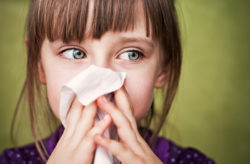Allergic Rhinitis
What is allergic rhinitis?
 Known to most people as hay fever, allergic rhinitis is a very common medical problem affecting more than 15 percent of adults and children. Allergic rhinitis takes two different forms:
Known to most people as hay fever, allergic rhinitis is a very common medical problem affecting more than 15 percent of adults and children. Allergic rhinitis takes two different forms:
- Seasonal: Symptoms of seasonal allergic rhinitis occur in spring, summer and/or early fall. They are usually caused by allergic sensitivity to pollens from trees, grasses or weeds, or to airborne mold spores.
- Perennial: People with perennial allergic rhinitis experience symptoms year-round. It is generally caused by sensitivity to house dust mites, animal dander, cockroaches and/or mold spores. Underlying or hidden food allergies rarely cause perennial nasal symptoms.
Some people may experience both types of rhinitis, with perennial symptoms getting worse during specific pollen seasons. There are also non-allergic causes for rhinitis.
What causes the sneezing, itchy eyes and other symptoms?
When a sensitive person inhales an allergen (allergy-causing substance) like ragweed pollen, the body’s immune system reacts abnormally. The allergen binds to allergic antibodies (immunoglobulin E, or IgE) that are attached to cells that produce histamine and other chemicals. The pollen “triggers” these cells in the nasal membranes, causing them to release histamine and the other chemicals. Histamine dilates the small blood vessels of the nose making fluids leak out into other tissues. This causes runny noses, watery eyes, itching, swelling and other allergy symptoms.
Antibodies circulate in the blood stream, and collect in the tissues of the nose and in the skin. This makes it possible to show the presence of these antibodies by skin testing, or less commonly, by a special IgE allergy blood test. A positive skin test mirrors the type of reaction going on in the nose.
No hay, no fever, so why “hay fever”?
“Hay fever” is a century-old term that has come to describe the symptoms of allergic rhinitis, especially when it occurs in the late summer. However, the symptoms are not caused by hay (ragweed is one of the main culprits) and are not accompanied by fever. So, the term “allergic rhinitis” is more accurate. Similarly, springtime symptoms are sometimes called “rose fever,” but it’s just coincidental that roses are in full-bloom during the grass-pollinating season. Roses and other sweet-smelling, showy flowers rely on bees, not the wind, for pollination. Not much of their pollen gets into the air to cause allergies.
Is there any escape?
A common question from allergic rhinitis sufferers is: Can I move someplace where my allergies will go away? Some allergens are tough to escape. Ragweed, which affects 75 percent of allergic rhinitis sufferers, blankets most of the United States. Less ragweed is found in a band along the West Coast, the southern-most tip of Florida and northern Maine, but it is still present. Even parts of Alaska and Hawaii have a little ragweed.
Allergists seldom recommend moving to another locale as a cure for allergies. A person may escape one allergy to ragweed, for example, only to develop sensitivity to grasses or other allergens in the new location. Since moving can have a disrupting effect on a family financially and emotionally, relocation should be considered only in an extreme situation and only after consultation with an allergist.
Can allergic rhinitis cause other problems?
Some known complications include ear infections, sinusitis, recurrent sore throats, cough, headache, altered sleep patterns, fatigue, irritability and poor school performance. Occasionally, children may develop altered facial growth and orthodontic problems.
Click on the providers’ images below to learn more about our Allergy team.
Providers in this Specialty

Vivek Agarwal, MD
Allergy / Immunology, Asthma
